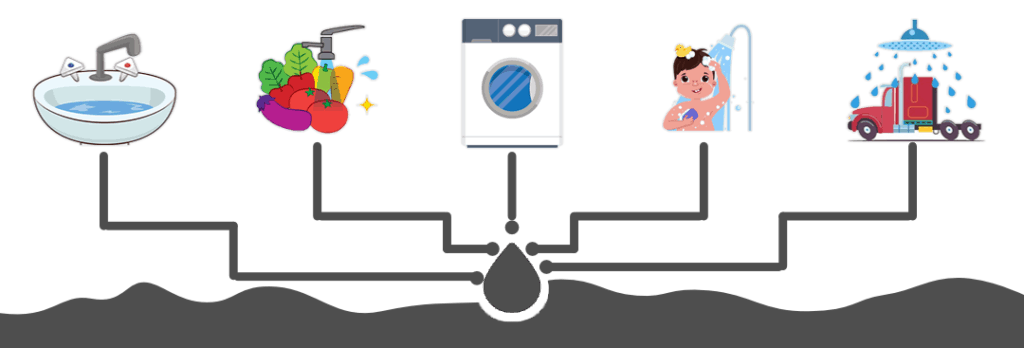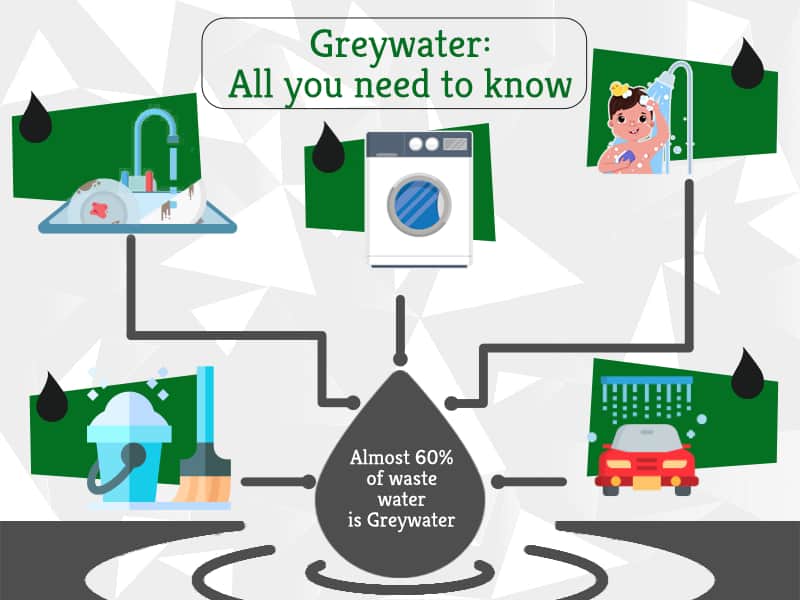Approximately 60% of water that is consumed is converted to Greywater.

With growing concerns over water scarcity and sustainable living, greywater reuse is gaining attention as an efficient way to conserve water. This lightly used water from households offers a valuable source for non-potable applications like irrigation and flushing. Properly managed, greywater can reduce freshwater demand, protect the environment, and lower utility bills. Here’s everything you need to understand about greywater, from its definition to its treatment and uses.
What is Greywater?
The term “Greywater” can be defined as untreated wastewater generated either directly or indirectly by human activities that does not contain faeces.
When this untreated wastewater is stored, even for short periods, the water often clouds and turns grey in colour. This is why it is called as greywater.
Greywater is also referred to as Sullage or foul water.
While greywater looks dirty, it can be used for several different applications before being completely discarded into the sewage system for treatment.
Though not entirely free of contaminants, greywater contains fewer pathogens than blackwater, making it suitable for non-potable uses such as toilet flushing and garden irrigation. In homes with conventional flush toilets, greywater makes up about 65% of total wastewater, making it a valuable resource for water conservation. However, if stored too long, its quality can deteriorate due to warmth and organic matter, which may lead to odours and microbial growth. For safety and effectiveness, greywater should be reused promptly or treated appropriately.
Sources of Greywater
By definition, all greywater is wastewater, but not all wastewater is greywater. Some definitions include the water sourced from various kitchen appliances, while others don’t.
Some common sources of greywater are:
– Basins/Sinks
– Showers
– Washing Machines
– Kitchen Appliances
– Washing of cars
– Washing of homes/offices
The exact sources of greywater may vary according to countries and organisations.
Quality of Greywater
The quality of the greywater determines the applications for which it can be used effectively. Greywater is usually warm and contains different types of organic matter and some nutrients.
Here is a list of common sources of greywater.
| Source | Possible Contents |
| Washing Machine | Suspended Solids(dirt,lint), organic material, oil and grease, sodium, nitrates and phosphates (from detergent), bleach |
| Dishwashers | Organic Material, suspended solids (food particles),bacteria, detergent, oil, grease |
| Shower, washbasins | Bacteria, hair, organic material, suspended solids (skin, particles), oils, soap, shampoo, toothpaste |
| Kitchen Sinks | Bacteria, organic matter, suspended solids (food particles), fat, oils, grease, soap, detergent residue |
| Floor and other washing wastes | Dirt, soap, detergent, bacteria |
| Typical Composition of Greywater | ||
| Parameter | Unit | Range/Value |
| Parameter | Unit | Range/Value |
| Suspended Solids | mg/L | 45-330 |
| Turbidity | NTU | 22-200 |
| BOD5 | mg/L | 90-290 |
| Nitrite | mg/L | <0.1-0.8 |
| Ammonia | mg/L | <0.1-25.4 |
| Total Kjeldahl Nitrogen | mg/L | 2.1-31.5 |
| Total Phosphorus | mg/L | 0.6-27.3 |
| Sulphate | mg/L | 7.9-110 |
| pH | – | 6.6-8.7 |
| Conductivity | mS/cm | 325-1140 |
| Sodium | mg/L | 29-230 |
Depending on how the greywater is managed, its contents and nutrients can benefit various applications.
Quantity of Greywater
Greywater quantity keeps on varying based on factors such as :
– Number of members in the household or offices
– Age distribution of members
– Lifestyle characteristics
– Water usage patterns
– Climatic and environmental conditions
It is estimated that greywater makes up approximately 60% of all wastewater. This means that 60% of all water that is consumed will be converted to greywater.
As identified by standard water requirements, an individual can consume approximately 135 lpd. This would imply that an individual can generate approximately 81 L of greywater per day.
Greywater generated by an individual:
– Per day = 81 L
– Per Week = 567 L
– Per Month = 2,430 L
– Per Year = 29,565 L
Applications or Uses of Greywater
Depending on its source and composition, greywater has varied applications as non-potable water. Though it is not impossible to use untreated greywater, treated greywater has more applications.
– Toilet Flushing
– Gardening, Irrigation or Landscaping
– Firefighting
– Heat Reclamation
– Industrial Use
– Car Washing
– Ornamental uses in fountains, artificial waterfalls
Process of Greywater Treatment
Treating greywater effectively ensures its safe reuse for non-drinking purposes like irrigation and toilet flushing. Since it contains fewer contaminants than sewage, greywater can be treated through simple yet efficient methods, especially when separated from blackwater.
Separate from Toilet Wastewater:
Greywater should be kept apart from toilet waste to reduce pathogen levels and simplify treatment. This separation makes the water safer and easier to recycle.
Supports Source Separation:
Keeping greywater isolated aligns with ecological sanitation practices, which promote managing different waste streams individually for better resource recovery.
Pre-treatment for Kitchen Greywater:
Water from kitchen sinks often contains grease, oil, and food particles. To prevent clogging and odours, these should be filtered out before the water is directed into storage or treatment systems.
Easier to Treat than Sewage:
Since greywater carries fewer contaminants than blackwater, its treatment and reuse require less complex systems and are more cost-effective.
Treatment Methods:
Greywater can be processed using a variety of methods, depending on the scale and purpose:
Biological Systems: Constructed wetlands and vertical green walls naturally filter and break down organic matter.
Mechanical Systems: Sand filters, gravel or lava rock beds help remove particulates, while UV disinfection systems target harmful microbes.
Benefits of Greywater Systems
Greywater systems offer a practical solution for conserving water and promoting environmental sustainability. By reusing lightly used household water, these systems reduce freshwater demand, lower treatment costs, and support eco-friendly practices across homes, farms, and communities.
Supports Irrigation Needs:
Greywater is widely considered safe for irrigation, especially in dry regions. Research shows that its use in agriculture poses minimal health risks when appropriately managed.
Boosts Groundwater Recharge:
When greywater is absorbed into the soil, natural filtration processes enhance water quality, helping replenish and purify underground water reserves.
Relieves Pressure on Water Supply:
Reusing greywater reduces reliance on freshwater for non-potable uses like toilet flushing and gardening, easing demand on municipal water systems.
Promotes Sustainable Water Use:
Greywater systems provide an alternative source of water, especially during water shortages or droughts, promoting water conservation and sustainable development.
Environmentally Friendly:
Diverting greywater from sewage systems lessens the volume of wastewater discharged into rivers or lakes, protecting ecosystems from pollution.
Reduces Energy and Chemical Use:
Treating and recycling greywater on-site reduces the need for centralised treatment processes, saving energy and minimising chemical runoff.
Economic Advantages:
Households and institutions can benefit from lower water bills and reduced infrastructure strain, making greywater systems cost-effective in the long run.
Minimises Groundwater Depletion:
With less need to extract freshwater from aquifers, greywater use helps curb overuse of groundwater resources, preserving them for future needs.
Guidelines for Greywater Reuse
The following objectives help establish the basic guidelines for reusing greywater effectively.
– Prevention of
– Public Health Risk
– Possible disease transmission arising from improper greywater reuse
– Ensuring the greywater systems do not pose any harm to the environment or native ecosystems
– Protection of
– Groundwater
– Surface Water
– Land and Vegetation
Working of the Greywater System
The working of the greywater system consists of four steps:
Collection of Greywater
– Several methods can be employed to collect greywater from all its different sources. It is highly recommended to install proper plumbing in order to collect this greywater since it requires less maintenance and can transfer the collected greywater directly to its designated storage.
Storage and Treatment
Collected greywater is immediately stored. It is recommended that it be stored for less than 24 hours. To store it for longer periods for various applications, it should be filtered to remove suspended solids and particles and then treated with Chlorine or Iodine.
Based on the application for which the greywater is going to be used, different treatment procedures may also be adopted.
Use of Greywater
Methods to collect Greywater
In order to reuse greywater, it is imperative to collect the greywater. The following methods can be adopted for the same:
Manual Collection – To collect using a bucket or jug by hand
Simple Piping – To collect using plumbing connections and systems between the source and the storage tank or the area of application
Integrated Sewage and Piping – To collect using plumbing connections and systems between all sources and the collection tank, with provisions for treating the greywater with chlorine or iodine for more extended storage.
FAQS
What is Greywater?
Greywater is gently used water from household sources like sinks, showers, and washing machines, excluding water mixed with toilet waste.
What are the Three Types of Greywater Systems?
a) Irrigation System – Used for watering gardens and landscapes.
b) Indoor Reuse System – Treats water for reuse in toilet flushing.
c) Clothes Washer System – Collects water from washing machines for outdoor use.
What is the Purpose of Greywater Management?
To offer safe reuse guidelines that protect public health, the environment, and support water conservation.
Is Greywater Safe for Plants and Soil?
Yes, when properly treated and applied, greywater is generally safe and beneficial for plant growth and soil health.

